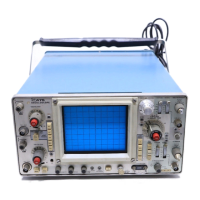TM 11-6625-2735-14-1
Q1312 and Q1310 compose an overvoltage protection
circuit. In the event the regulating action of the circuit
should cause the CRT cathode supply to approach
approximately –3000 volts, the voltage level at the emitter
of Q1316 will be very close to –6 volts. Normally Q1312
and Q1310 are biased off and do not conduct. When the
voltage level at the emitter of Q1316 reaches approximate-
ly –6volts, Q1312 is biased into conduction, which in turn
biases Q1310 on. Q1310 now starts to reduce the base
drive applied to Q1318 and prevents the amplitude of
oscillations from increasing. This prevents the CRT
cathode supply from going more negative than ap-
proximately –3300 volts.
Higih-Voltage Rectifiers and Output
The high-voltage transformer T1320 has two output
windings. One winding provides filament voltage for the
cathode-ray tube. The filament voltage can be supplied
from the High-Voltage Supply, since the cathode-ray tube
has a very low filament current drain. The filament of the
cathode-ray tube is elevated to the cathode level to
prevent cathode-to-filament arcing. The other winding of
T1320 is used to derive both the negative cathode
potential and the positive anode accelerating potential.
The positive accelerating potential is supplied by High
Voltage Multiplier U1321. Regulated output voltage is
approximately +15,500 volts, The negative cathode poten-
tial is supplied by a voltage doubler circuit, C1320, CR1320
and CR1321. Voltage output is –2450 volts. Variations in
supply voltage are monitored by the High-Voltage
Regulator circuit to provide a regulated high-voltage
output.
Control-Grid DC Restorer
The Control-Grid DC Restorer couples dc and low
frequency components of the Z-Axis Amplifier signal to
the CRT control grid. This allows the Z-Axis Amplifier to
control the CRT beam current (intensity). The potential
difference between the Z-Axis Amplifier output and the
control grid (about 2450 volts) prohibits direct coupling.
The dc restorer is actually a cathode-referenced bias
supply for the CRT control grid. Quiescently, its output
voltage is more negative than the CRT cathode by an
amount set by the voltage level across VR1374, the setting
of Grid Bias adjustment R1375, and the voltage at the
output of the Z-Axis Amplifier.
When the secondary-winding output of T1320 swings
positive, C1372 charges through C1326, R1326, R1372,
CR1379, and R1379 to a voltage level that equals the
voltage determined by VR1374 and the setting of Grid Bias
adjustment R1375. At this voltage level, (approximately
+15 volts) CR1373 turns on, preventing any additional
increase in positive voltage. When the secondary-winding
output swings negative, CR1373 turns off, then CR1371
turns on and clamps the less positive voltage swing at
C1372 to the voltage level of the Z-Axis Amplifier. During
this less positive voltage swing, C1372 discharges through
CR1377 into C1371. Capacitor C1371 holds the voltage
constant at the CRT control grid; it also provides a path for
the fast rising and falling portions of the Z-Axis Amplifier
output to be coupled to the CRT control grid for blanking
and unblinking.
CRT Control Circuits
Focus of the CRT display is controlled by FOCUS
control R1380. The Focus Tracking control, R1335B,
located in a series resistor network with the FOCUS
control, is ganged with the INTENSITY control to reduce
focus variations when changing the INTENSITY setting.
The ASTIG adjustment R1397 which is used in conjunc-
tion with the FOCUS control to provide a well-defined
display, varies the positive level on the astigmatism grid.
Geometry adjustment R1390 varies the positive level on
the horizontal deflection plate shields to control the
overall geometry of the display.
Two adjustments control the trace alignment by vary-
ing the magnetic field around the CRT. Y Align adjustment
R1385 controls the current through L1385, which affects
the CRT beam after vertical deflection but before horizon-
tal deflection. Therefore, it affects only the vertical (Y)
components of the display. TRACE ROTATION adjust-
ment R1386 controls the current through L1386 and
affects both vertical and horizontal rotation of the beam.
Z-Axis Amplifier
The Z-Axis Amplifier circuit controls the CRT intensity
level from several inputs. The effect of these input signals
is to either increase or decrease the trace intensity, or to
completely blank portions of the display. The input
transistor, Q1338, is a current-driven, low input im-
pedance amplifier. It provides termination for the input
signals as well as isolation between the input signals and
the following stages. The current signals from the various
control sources are connected to the emitter of Q1338 and
the algebraic sum of the signals determines the collector
conduction level.
Q1344, Q1352, Q1354, Q1358, and Q1362 compose a
feedback amplifier stage. R1369 is the feedback resistor
and C1352 provides high-frequency compensation.
Q1344 is an emitter follower that provides drive to the
output complementary amplifier made up of Q1352,
Q1354, and Q1358. Q1358 is a device with higher frequen-
cy characteristics than Q1354 and is used to improve the
overall frequency capabilities of the Z-Axis Amplifier. On
the fast positive-going output signal peaks, Q1358
depletes the charge on C1358. Then, on the negative-
3-26

